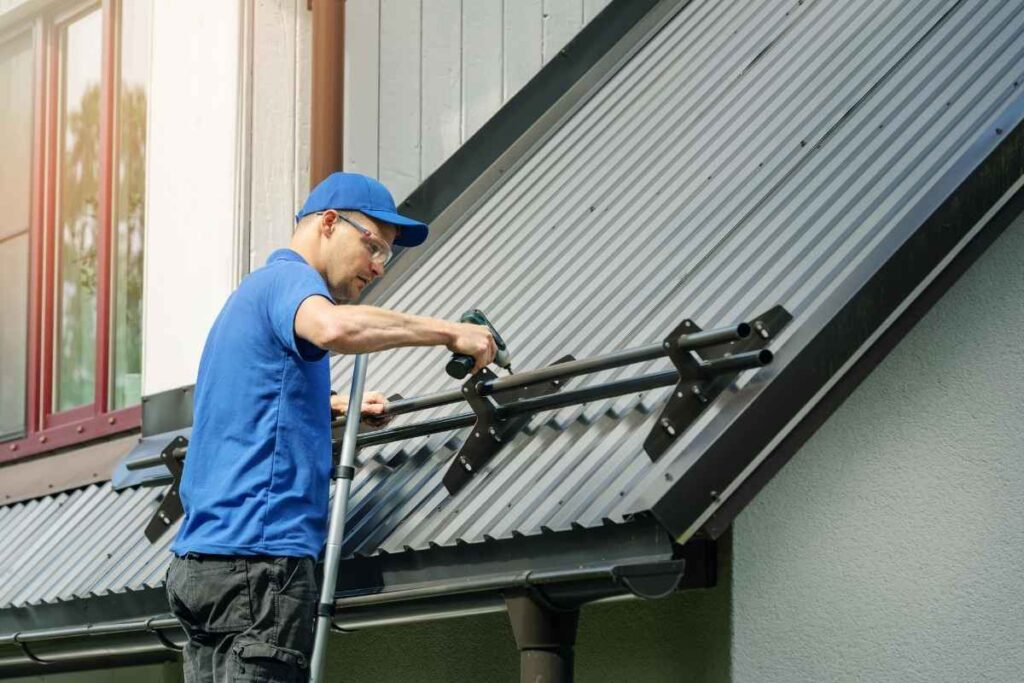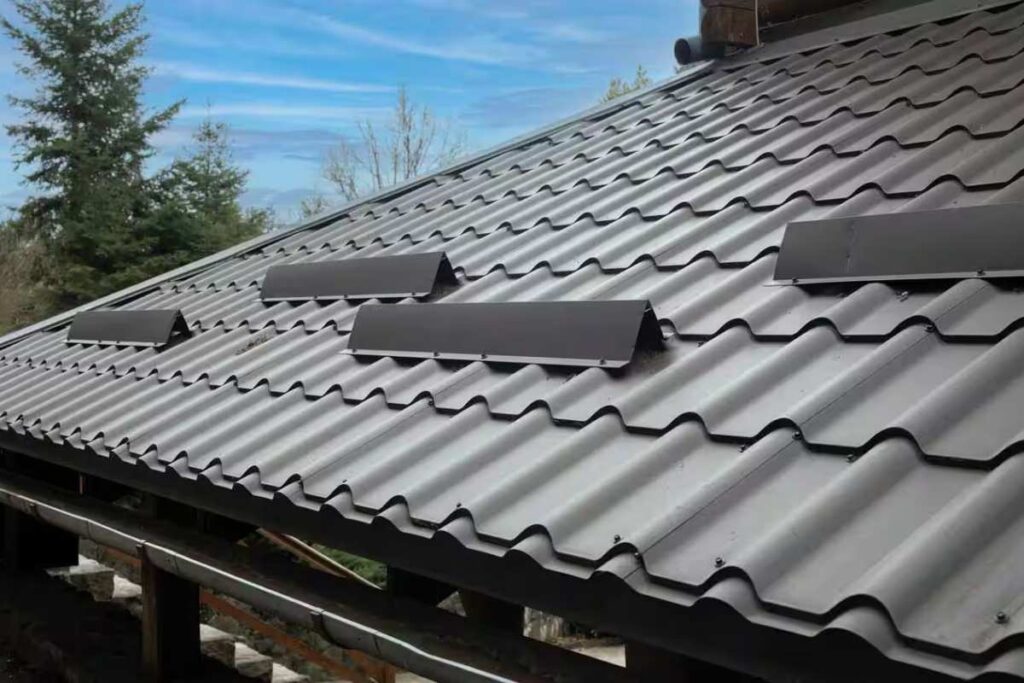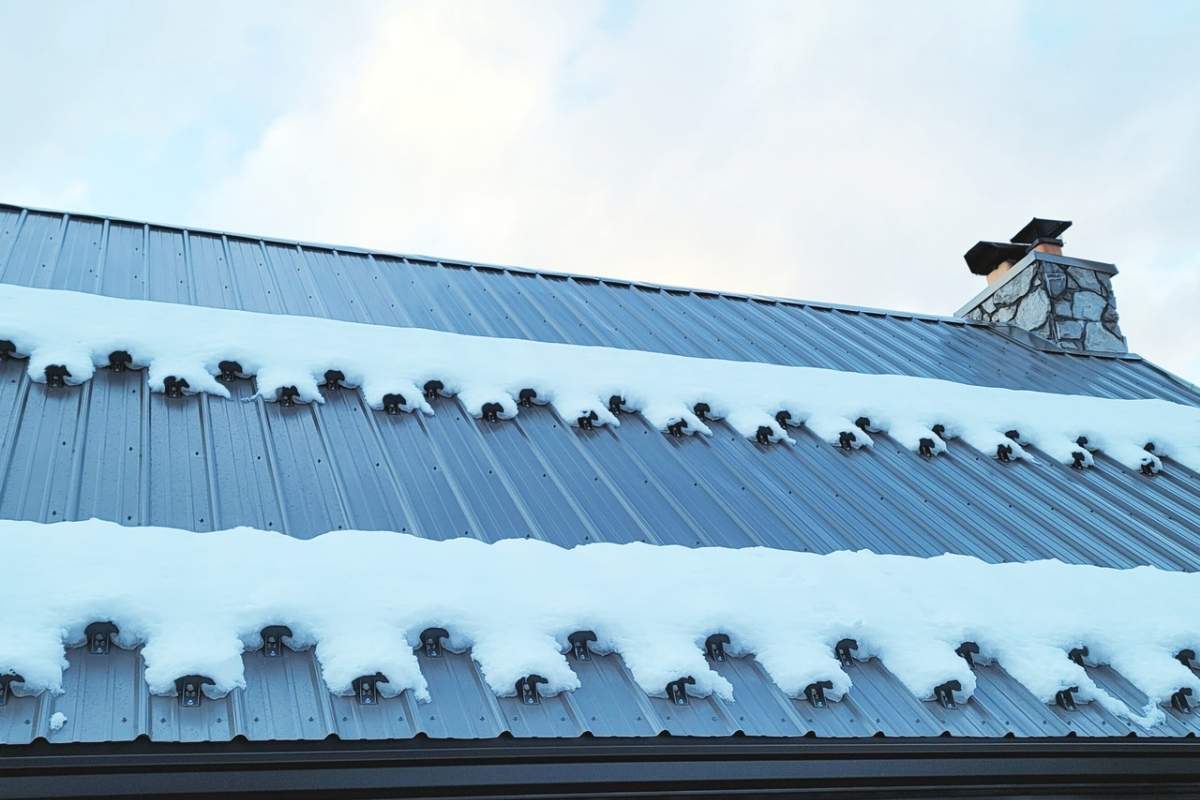Falling snow and ice from metal roofs pose serious safety risks to people and property below. When choosing between metal roof snow guards vs snow rails, property owners must carefully consider their specific needs and circumstances.
Initially, both systems serve the same primary purpose – preventing dangerous snow slides. While snow guards are individual devices costing between $10 to $15 per linear foot, snow rails provide continuous protection at $12 to $40 per linear foot. The choice between metal roof snow guards vs snow rails pros and cons often comes down to specific factors like roof size and local weather patterns.
For instance, snow guards work well for breaking up snow sheets into smaller sections, whereas snow rails create stronger barriers against sliding snow, making them ideal for areas with heavy snowfall. When considering metal roof snow guards vs snow rails cost, property owners should note that both systems offer impressive durability, lasting 20 years or more with proper installation and maintenance.
This guide examines the key differences between these snow retention systems to help property owners make an informed decision for their specific situation.
Metal Roof Snow Guards vs Snow Rails Explained
Snow retention systems come in two main forms, each designed to manage snow accumulation on metal roofs differently. Understanding metal roof snow guards vs snow rails requires examining their unique characteristics and applications.
What are snow guards?
Snow guards are individual devices installed across metal roofs in staggered patterns. These small but effective components create friction that slows down moving snow, preventing sudden avalanches. Snow guards typically cost between $10 to $15 per linear foot, making them a cost-effective choice for residential properties. Additionally, these devices allow debris like tree branches and leaves to fall naturally off the roof, reducing maintenance requirements.
How do snow rails work?
Snow rails function as continuous horizontal barriers spanning the entire length of the roof. These systems create a robust defense against snow slides through their uninterrupted design. Furthermore, snow rails excel at distributing weight evenly across the roof’s surface, which helps maintain structural integrity during heavy snowfall. Although snow rails represent a higher initial investment, their comprehensive coverage often proves more economical for larger roofs.
Basic differences in design
The fundamental distinctions between metal roof snow guards vs snow rails extend beyond their basic appearance. Here are the key differences that impact their performance:
- Installation Method
- Snow guards offer flexible placement options, with three primary installation methods:
- Clamped to standing seams
- Mechanically attached with screws
- Adhered using specialized adhesives
- Snow rails require linear installation along roof edges, often utilizing mechanical fasteners or seam clamps for secure attachment
- Visual Impact Snow guards present a more subtle appearance, as their smaller size and strategic placement make them less noticeable from ground level. Conversely, snow rails create a more prominent visual element due to their continuous design. Both systems can be color-matched to complement the roof’s appearance.
- Performance Characteristics Snow guards excel at breaking up snow into smaller, manageable amounts. This characteristic makes them particularly effective for residential properties and regions with moderate snowfall. On the other hand, snow rails provide superior protection against large snow loads. Their design allows them to handle significant accumulation, especially beneficial in areas experiencing heavy, wet snow conditions.
The choice between these systems often depends on specific factors such as roof pitch, local weather patterns, and building requirements. Both metal roof snow guards vs snow rails pros and cons must be carefully evaluated based on individual circumstances. Moreover, considering metal roof snow guards vs snow rails cost alongside performance requirements helps ensure the most appropriate selection for each project.
Key Factors That Impact Your Choice

Selecting between metal roof snow guards vs snow rails requires careful evaluation of several crucial factors that directly impact their effectiveness. Understanding these elements ensures optimal protection against snow-related hazards.
Roof pitch and design
The angle of a roof significantly influences snow retention needs. Roofs with slopes less than 22 degrees rarely experience avalanche conditions. Nevertheless, metal roofs can allow snow to slide at pitches as low as 1/12. For steeper pitches between 30 and 45 degrees, snow movement becomes more likely, requiring robust retention systems.
Complex roof designs with valleys, dormers, or skylights demand specialized placement of snow retention systems. Furthermore, the type of metal panels and their surface finish affect how snow behaves on the roof. Smooth, simple roof designs typically manage snow more effectively, yet they still require appropriate snow retention measures based on their pitch.
Local snow patterns
The geographical location and typical snowfall patterns play a vital role in choosing between metal roof snow guards vs snow rails pros and cons. The tributary force calculation considers:
- Regional snow load averages
- Roof slope impact
- Length of the roof span
In regions experiencing heavy snowfall, like the Prairies or East Coast, snow rails often prove more suitable. These areas require systems capable of handling substantial snow loads consistently throughout winter. The metal roof snow guards vs snow rails cost becomes a secondary consideration when safety and structural integrity are paramount.
Building height
Taller structures face unique challenges regarding snow retention. As building height increases, wind exposure significantly affects snow distribution patterns. This factor becomes particularly crucial when evaluating metal roof snow guards vs snow rails for multi-story buildings.
The relationship between height and snow retention involves several key considerations:
- Wind exposure increases with building height
- Snow distribution patterns become more complex
- Surface area exposed to wind grows larger
Consequently, the snow retention system must account for these height-related factors to ensure effective performance. The placement and quantity of retention devices should be calculated based on:
- Maximum snow load capacity
- Panel layout specifications
- Local weather patterns
For optimal protection, the number of retention devices needed per panel depends on dividing the tributary force by the allowable load for each device. This calculation ensures adequate coverage while considering the spacing between panel ribs and roof length.
Installation Requirements and Challenges
Proper installation stands as the cornerstone of effective snow retention systems. Before comparing metal roof snow guards vs snow rails, understanding the installation requirements ensures optimal performance and longevity of these protective measures.
Tools and equipment needed
Installing metal roof snow guards vs snow rails demands specific tools for precise placement. A torque wrench proves essential for standing seam installations, enabling accurate set screw tightening to manufacturer-specified inch-pounds. For exposed fastener roofs, a drill driver offers better control compared to impact drivers, which often deliver excessive torque.
Essential equipment includes:
- Calibrated torque wrench (140-180 in/lbs recommended)
- Water-soluble marking pen
- String lines for alignment
- Appropriate fasteners based on roof type
The choice between metal roof snow guards vs snow rails pros and cons extends to fastener selection. Larger screws (#12 or #14) provide superior pullout strength, crucial for retaining heavy snow loads. Accordingly, clamp selection must match the specific standing seam profile to ensure proper fit without forcing.
Common installation mistakes
Understanding potential pitfalls helps avoid costly errors when deciding between metal roof snow guards vs snow rails cost considerations. The most frequent installation mistakes include:
- Inadequate Layout Planning
- Single row placement near eaves instead of multiple staggered rows
- Isolated placement around doors and vents
- Failing to follow manufacturer-specified spacing guidelines
- Structural Support Issues
- Not securing guards to robust substrates like wood decking or purlins
- Overlooking the need for internal blocking in areas lacking structural support
- Improper torque application on set screws
- Adhesive Application Errors
- Insufficient cure time for adhesive-mounted systems
- Installing in temperatures below 50°F, affecting adhesive performance
- Not allowing proper set time for initial bond formation
Proper spacing emerges as critical for both systems. Snow guards require placement according to precise calculations based on roof pitch, snow load, and panel measurements. Similarly, snow rails demand careful attention to seam attachment, with F-Castings placed up to 48 inches apart depending on building location and panel length.
For mechanically mounted systems, verification of proper torque remains vital. After initial installation, experts recommend returning to each screw for a second tightening to ensure sustained security. Furthermore, adhesive-mounted systems perform best when installed during late spring or early summer, allowing optimal curing conditions.
Cost Analysis of Snow Guards vs Snow Rails
Understanding the financial implications helps property owners make informed decisions about metal roof snow guards vs snow rails. A thorough cost analysis reveals distinct differences in both upfront expenses and ongoing maintenance requirements.
Initial installation expenses
The choice between metal roof snow guards vs snow rails cost varies significantly based on coverage needs and installation methods. Snow guards present a more budget-friendly option, ranging from $3 to $8 per piece. In contrast, rail systems command $20 to $30 per linear foot.
Labor costs add another layer to the financial consideration. Professional installation typically ranges from $50 to $100 per hour. The total project cost for snow guards spans from $500 to $2,500, depending on these key variables:
- Roof complexity and size
- Material selection
- Installation method requirements
- Local labor rates
For comprehensive coverage, snow guards average $5 to $10 per square foot of roof area, yet snow rails demand $15 to $25 per square foot. The metal roof snow guards vs snow rails pros and cons extend beyond initial pricing – material quality plays a crucial role in long-term performance.
Long-term maintenance costs
Maintenance requirements differ substantially between these snow retention systems. Snow rails demonstrate superior durability with minimal upkeep needs. Their robust construction reduces the likelihood of snow buildup or blockage, resulting in smoother operation throughout their lifespan.
Annual maintenance considerations include:
- Inspection costs ranging from $100 to $200
- Potential resealing of fastener points
- Verification of secure attachments
Snow guards might require more frequent attention since weather conditions and roof movement can affect their positioning. However, both systems offer impressive longevity when properly maintained:
- High-quality materials resist rust and deterioration
- Proper installation ensures sustained effectiveness
- Regular inspections prevent costly repairs
The investment value becomes apparent through:
- Reduced risk of structural damage
- Extended roof lifespan
- Lower repair expenses over time
For larger applications, snow rails often prove more cost-effective despite higher upfront costs. Their comprehensive coverage and durability can offset initial expenses through reduced maintenance needs. Nonetheless, snow guards remain financially practical for smaller roofs or targeted protection areas.
Plastic alternatives might tempt budget-conscious buyers, however, their tendency to crack necessitates more frequent replacement. Metal systems, though pricier initially, deliver superior value through extended service life. The decision ultimately hinges on balancing immediate budget constraints against long-term protection needs.
Through proper maintenance and quality materials, both systems contribute to sustainable roofing solutions by minimizing the need for frequent repairs or replacements. This approach not only preserves financial resources but also supports environmental conservation through reduced material waste.
Making the Final Decision

Choosing between metal roof snow guards vs snow rails requires careful consideration of specific scenarios and requirements. Property owners must evaluate their unique circumstances to determine the most effective snow retention solution.
When to choose snow guards
Snow guards emerge as the preferred choice for residential and smaller roofs. These individual devices prove particularly effective under several conditions:
First, snow guards work exceptionally well on roofs with less pitch, offering reliable protection without overwhelming the structure. Their staggered pattern installation helps break up snow, allowing it to fall in smaller, more manageable chunks rather than sudden avalanches.
Property owners should consider snow guards if:
- Trees surround the building, as these devices allow leaves and branches to fall freely
- Cost remains a primary concern, given their lower initial investment
- The roof requires a less noticeable snow retention solution
The metal roof snow guards vs snow rails pros and cons reveal that snow guards excel at targeted protection. Their individual placement enables strategic positioning around specific hazard areas, making them ideal for properties with unique architectural features.
When snow rails make more sense
For larger roofs where metal roof snow guards vs snow rails cost becomes secondary to performance, snow rails present compelling advantages. These continuous systems demonstrate superior strength through proper clamp numbers.
Snow rails prove most beneficial under these circumstances:
- Areas experiencing heavy, wet snow conditions
- Steeper roof pitches requiring robust snow retention
- Properties demanding uniform snow management across extensive roof surfaces
The continuous design of snow rails distributes snow loads evenly across the roof structure. This characteristic proves particularly valuable for buildings in regions like the Prairies or East Coast, where substantial snowfall occurs regularly.
Snow rails demonstrate remarkable effectiveness through their ability to handle larger quantities of snow without compromising structural integrity. Their robust construction minimizes the risk of snow build-up or blockage, resulting in reduced maintenance requirements throughout their lifespan.
Ultimately, the decision between metal roof snow guards vs snow rails hinges on several key factors:
- Roof size and configuration
- Local climate conditions
- Budget constraints
- Esthetic preferences
- Maintenance capabilities
For properties with substantial roof areas coupled with regular heavy snowfall, snow rails often justify their higher initial cost through superior performance and reduced long-term maintenance needs. In essence, both systems can provide the desired result – controlling falling snow to protect those underneath. The final choice should align with specific property requirements rather than general preferences.
Metal Roof Snow Guards Vs Snow Rails Frequently Asked Questions
Are snow guards essential for metal roofs?
Snow guards are crucial for metal roofs in areas with significant snowfall. They prevent dangerous snow slides, reduce injury risks, protect property, and contribute to the longevity of the roof. However, their necessity depends on factors like local climate, roof pitch, and building design.
What’s the main difference between snow guards and snow rails?
Snow guards are individual devices installed in a pattern to create friction and hold snow in place, while snow rails are continuous barriers spanning the roof’s length. Snow guards are more suitable for smaller roofs and moderate snowfall, whereas snow rails offer stronger protection for larger roofs and areas with heavy snow accumulation.
How much does it typically cost to install snow retention systems on a metal roof?
The cost of installing snow retention systems varies widely. Snow guards generally range from $500 to $2,500 for a project, while snow rails can cost between $15 to $25 per square foot of roof area. Factors affecting the price include roof size, complexity, material choice, and local labor rates.
What are the key factors to consider when choosing between snow guards and snow rails?
Important factors include roof pitch and design, local snow patterns, building height, installation requirements, and long-term maintenance costs. Snow guards are often preferred for residential properties and smaller roofs, while snow rails are typically better suited for larger commercial buildings in areas with heavy snowfall.
How do metal roofs handle snow accumulation compared to other roofing materials?
Metal roofs are smooth and slippery, which can lead to sudden snow slides if not properly managed. This is why snow retention systems are particularly important for metal roofs. With the right snow guards or rails installed, metal roofs can effectively manage snow accumulation, preventing dangerous avalanches while allowing for gradual melting and controlled snow release.
Do snow guards or snow rails require regular maintenance?
Both systems are designed for durability, but periodic checks are recommended. Snow guards should be inspected for secure attachment, while snow rails need bolts and brackets checked for stability. Regular maintenance ensures long-term effectiveness, especially in heavy snow regions.
Can snow guards and snow rails be installed on existing metal roofs?
Yes, both can be retrofitted onto existing metal roofs. Snow guards are easier to install individually, while snow rails require more structural consideration. A professional assessment can help determine the best installation method for your roof.
Which option is better for areas with extreme snowfall?
Snow rails are generally more effective for heavy snowfall since they create a continuous barrier, preventing large snow slides. Snow guards work well in moderate conditions but may require more placements in extreme snow zones.
Do snow retention systems affect roof warranties?
Some manufacturers may void warranties if snow guards or rails are improperly installed. It’s important to use recommended products and follow manufacturer guidelines to maintain your roof’s warranty coverage.
